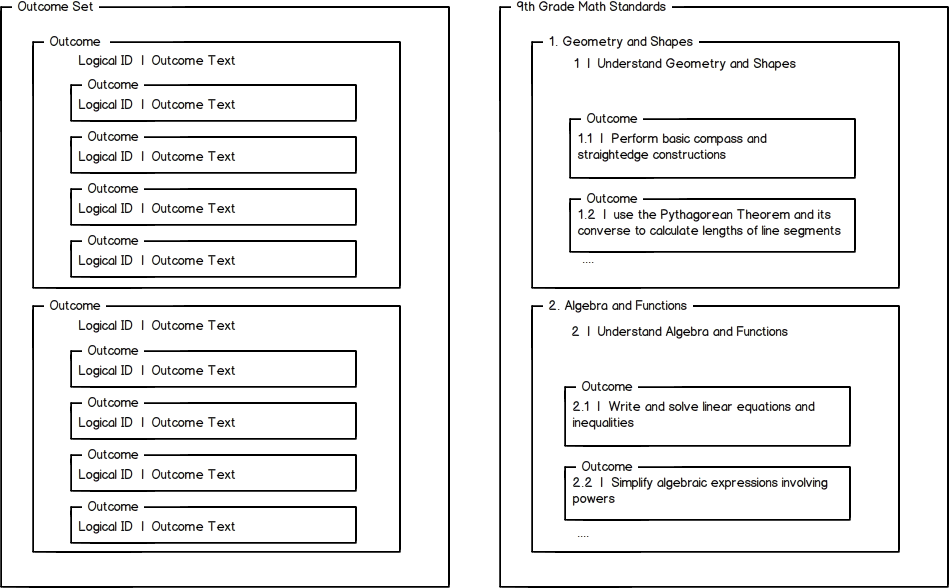Outcomes Logical Overview
Description
This page is designed to give a logical overview of the various components and how they fit together. It also gives a lot of examples of very specific use cases and how they should work.
Outcomes and Outcome Sets
The fundamental building block of the Outcomes System is the Outcome itself. An *outcome* is often referred to in various geographies differently, by names like Goal, Competency, Skill, or Standard. Typically, it is very granular, and, for most well designed outcome-based learning approaches, it is specifically measurable. Outcomes have text that describes the outcome, and also they have some type of logical identifier. So, for example, and Outcome might be "Student Can use the Pythagorean Theorem to calculate lengths of line segments of a right triangle." The logical identifier for this might be 8.3.1. So, from a logical perspective. The Outcome is made up of its text and its logical identifier.
An Outcome Set is a grouping of outcomes, and it can have multiple levels of logical groupings. So, for example, one logical grouping might be Physics Department Learning Goals, another grouping might be Nursing Practitioner Skills, or a third might be 9th Grade Math Standards. From there, you could have sub categories (outcome sets). An example might be that the 9th Grade Math Standards. They could have a sub category of "Geometry and Shapes" and another subcategory of "Linear Equations", each with their own standards. Here is a logical diagram of an outcome set, and an example:
Relationship to a Course
In order to make the outcomes useful, they need to be used in a course, by mapping activities, resources, etc. to an outcome. However, there could be thousands of individual outcomes in a Moodle, so we want to simplify interfaces and relationships in the system. This is achieved by allowing an administrator or (optionally) an instructor to map their course against an Outcome Set. Once they have made this association, this outcome set will be the default outcome set for mapping and reporting, greatly simplifying the workflow for the user. A course can be mapped against 0, 1, or many Outcome Sets.
Let me give a couple of specific examples where this is important:
Backup and Restore of Mapped Content
Assume that I have backed up a course that has mapped all of its content against Outcome Set A. I now restore that content into a new course, which only has an association with Outcomes Set B. Two important things here:
- The mappings to Outcome Set A are not lost. They transfer with the content.
- The Mappings to Outcome Set A are not visible unless the new course is also mapped against Outcome Set A.
Accidental Deletion of Course Mapping
Assume that a course is mapped against Outcome Set Z. The instructor has spent the last two weeks creating content and mapping it against individual items and questions, etc. As part of the batch process that runs to update courses from the Student Information System, the mapping of the course to Outcome Set Z is lost. This should NOT be cascaded down to delete all of the individual content mappings. The mappings should remain, and, if the course is reassociated with Outcome Set Z, the mappings will appear.
Relationship to Activities, Resources, Quiz Questions, and Rubric Rows
While you can map an outcome set to a course, the key relationship is really when an outcome itself is mapped against an activity, resource, quiz question or rubric row. This is the key relationship, because this is how performance is measured. A couple of key points about the relationships here:
- An Outcome can be mapped against multiple resources, activities, quiz questions, etc. within the same course.
- An Activity, resource, etc. can have multiple outcomes mapped against it as well (Example: A video lecture might cover 8 or 9 different outcomes)
- An activity, resource, etc. can be mapped against multiple outcomes from DIFFERENT outcome sets at the same time.
Here is a diagram displaying the relationship examples:


